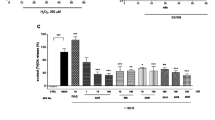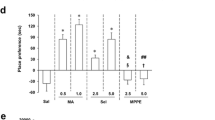Summary
Prior studies concluded that 1-methyl-4-phenyl-1,2,3,6-tetrahy-dropyridine (MPTP, a toxin causing parkinsonism) and its analogues are bioactivated by monoamine oxidase (MAO) to toxic pyridinium metabolites. Recently, a dissociation between the neuroprotective effects of deprenyl and its MAO inhibiting effects has been proposed. Furthermore, we have demonstrated that pyridinium metabolites of MPTP stimulate dopamine efflux and the formation of cytotoxic hydroxyl free radicals (OH) in the striatum. Therefore, we investigated possible neuroprotective mechanisms of propargyl MAO inhibitors by studying their effects on the formation of oxygen free radicals produced by dopamine autoxidation. Our recent in vivo results indicate that deprenyl and clorgyline given systemically suppressed the generation of OH that followed administration of 2’-methyl-MPTP. Combined deprenyl and clorgyline pretreatment are needed to block dopamine neurotoxicity elicited by 2’-methyl-MPTP. The present in vitro studies reveal that propargyl MAO inhibitors suppress non-enzymatic dopamine autoxidation and associated free radical production. Thus, OH generation evoked by MPTP analogues may be due mainly to a burst increase in iron-catalyzed autoxidation of released dopamine in the basal ganglia where high levels of iron and oxygen are present. Our present in vitro and prior in vivo results suggest that a novel antioxidant property of propargyl MAO inhibitors may contribute to protection against nigral lesions elicited by dopamine autoxidation following the administration of MPTP analogues.
Access this chapter
Tax calculation will be finalised at checkout
Purchases are for personal use only
Preview
Unable to display preview. Download preview PDF.
Similar content being viewed by others
References
Burns RS, Chiueh CC, Markey SP, Ebert MH, Jacobowitz DM, Kopin IJ (1983) A primate model of parkinsonism: selective destruction of dopaminergic neurons in pars compacta of the substantia nigra by N-methyl-4-phenyl-1,2,3,6-tetrahy-dropyridine. Proc Natl Acad Sci USA 80: 4546–4550.
Ben-Shachar D, Riederer P, Youdim MBH (1991) Iron-melanin interaction and lipid peroxidation: implications for Parkinson’s disease. J Neurochem 57: 1609–1614.
Birkmayer W, Knoll J, Riederer P, Youdim MBH, Hars V, Martin J (1985) Improvement of life expectancy due to l-deprenyl addition to madopar treatment in Parkinson’s disease: a long term study. J Neural Transm 64: 113–127.
Chiueh CC (1988) Dopamine in the extrapyramidal motor function: a study based upon the MPTP-induced primate model of parkinsonism. Ann NY Acad Sci 515: 226–238.
Chiueh CC, Huang S-J, Murphy DL (1992a) Enhanced hydroxyl radical generation by 2’-methyl analog of MPTP: suppression by clorgyline and deprenyl. Synapse 11: 346–348.
Chiueh CC, Krishna G, Tulsi P, Obata T, Lang K, Huang S-J, Murphy DL (1992b) Intracranial microdialysis of salicylic acid to detect hydroxyl radical generation through dopamine autoxidation in the caudate nucleus: effects of MPP+. Free Radic Biol Med 13: 581–583.
Chiueh CC, Miyake H, Peng MT (1993a) Role of dopamine autoxidation, hydroxyl radical generation, and calcium overload in underlying mechanisms involved in MPTP-induced parkinsonism. In: Narabayashi H, Nagatsu T, Yanagisawa N, Mizuno Y (eds) Parkinson’s disease: from basic research to treatment. Raven Press, New York, pp 251–258 (Adv Neurol 60).
Chiueh CC, Murphy L, Miyake H, Lang K, Tulsi PK, Huang S-J (1993b) Hydroxyl free radicals (OH) formation reflected by salicylate hydroxylation and neuro-melanin: in vivo markers for oxidant injury of nigral neurons. Ann NY Acad Sci 629: 370–375.
Cleeter MWJ, Cooper JM, Schapira AHV (1992) Irreversible inhibition of mitochondrial complex I by 1-methyl-4-phenylpyridinium: evidence for free radical involvement. J Neurochem 58: 786–789.
Cohen G, Pasik P, Cohen B, Leist A, Mytilineou C, Yahr MD (1984) Pargyline and deprenyl prevent the neurotoxicity of 1-methyl-4-phenyl-1,2,3,6-tetrahydropyridine (MPTP) in monkeys. Eur J Pharmacol 106: 209–210.
Cohen G (1988) Oxygen radicals and Parkinson’s disease. In: Halliwell B (ed) Oxygen radicals and tissue injury. FASEB, Bethesda, pp 130–135.
Dexter DT, Carter CJ, Wells FR, Javoy-Agid F, Agid Y, Lees A, Jenner P, Marsden CD (1989) Basal lipid peroxidation in substantia nigra is increased in Parkinson’s disease. J Neurochem 52: 381–389.
Donaldson J, LaBella FS, Gesser D (1981) Enhanced autoxidation of dopamine as a possible basis of manganese neurotoxicity. Neurotoxicology 2: 53–64.
Fornstedt B, Brun A, Rosengren E, Carlsson A (1989) The apparent autoxidation rate of catechols in dopamine-rich regions of human brains increases with the degree of depigmentation of substantia nigra. J Neural Transm [PD Sect] 1: 279–295.
Fornstedt B, Pileblad E, Carlsson A (1990) In vivo autoxidation of dopamine in guinea pig striatum increases with age. J Neurochem 55: 655–659.
Freisleben H-J, Lehr F, Fuchs J (1992) Lifespan of NMRI-mice is increased by deprenyl. Proceedings Int Amine Oxidase Workshop 5: 12 (Abst. #B02).
Graham DG (1978) Oxidative pathways for catecholamines in the genesis of neuro-melanin and cytotoxic quinones. Mol Pharmacol 14: 633–643.
Graham DG (1984) Catecholamine toxicity: a proposal for the molecular pathogenesis of manganese neurotoxicity and Parkinson’s disease. Neurotoxicology 5: 83–96.
Halliwell B (1989) Oxidants and the central nervous system: some fundamental questions, is oxidant damage relevant to parkinson’s disease, Alzheimer’s disease, traumatic injury, or stroke?. Acta Neurol Scand 126: 23–33.
Heikkila RE, Kindt MV, Sonsalla PK, Giovanni A, Youngster SK, McKeown KA, Singer TP (1988) Importance of monoamine oxidase A in the bioactivation of neurotoxic analogues of 1-methyl-4-phenyl-1,2,3,6-tetrahydrophyridine. Proc Natl Acad Sci USA 85: 6172–6176.
Hirsch E, Graybiel AM, Agid YA (1988) Melanized dopaminergic neurons are differentially susceptible to degeneration in Parkinson’s disease. Nature 334: 345–348.
Jenner P, Dexter DT, Schapira AHV, Marsden CD (1990) Free radical involvement and altered iron metabolism as a cause of Parkinson’s disease. In: Marsden CD, Fahn S (eds) The assessment and therapy of parkinsonism. Parthenon Publishing Group, New Jersey, pp 17–30.
Knoll J (1989) The pharmacology of selegiline [(—)deprenyl]: new aspects. Acta Neurol Scand 126: 83–91.
Magyar K, Tothfalusi L, Lengyel J, Gaal J (1992) Neuroprotective effect of deprenyl and p-fluoro-deprenyl against DSP-4 toxicity. Neurochem Int 21: D92 (abstract).
Markey SP, Johannessen JN, Chiueh CC, Burns RS, Herkenham MA (1984) Intra-neuronal generation of a pyridinium metabolite may cause drug-induced parkinsonism. Nature 311: 464–467.
Murphy DL, Sunderland T (1993) Monoamine oixdase inhibitors in neurodegenerative disorders. In: Kennedy SH (ed) Clinical advances in monoamine oxidase inhibitor therapies. American Psychiatric Press, Washington (in press).
Mytilineou C, Cohen G (1985) Deprenyl protects dopamine neurons from the neurotoxic effects of 1-methyl-4-phenylpyridinium ion. J Neurochem 5: 1951–1953.
Obata T, Chiueh CC (1992) In vivo trapping of hydroxyl free radicals in the striatum utilizing intracranial microdialysis perfusion of salicylate: effects of MPTP, MPDP+ and MPP+. J Neural Transm [Gen Sect] 89: 139–145.
Parkinson Study Group (1989) Effects of deprenyl on the progression of disability in early Parkinson’s disease. N Engl J Med 321: 1364–1371.
Poirier J, Donaldson J, Barbeau A (1985) The specific vulnerability of the substantia nigra to MPTP is related to the presence of transition metals. Biochem Biophys Res Commun 128: 25–33.
Riederer P, Sofic E, Rausch W-D, Schmidt B, Reynolds GP, Jellinger K, Youdim MBH (1989) Transition metals, ferritin, glutathione, and ascorbic acid in park-insonian brains. J Neurochem 52: 515–520.
Rinne JO, Roytta M, Paljarvi L, Rumnukainen J, Rinne UK (1991) Selegiline (deprenyl) treatment and death of nigral neurons in Parkinson’s disease. Neurology 41: 859–861.
Salo PT, Tatton WG (1991) Deprenyl reduces death of motoneurons caused by axotomy. J Neurosci Res 31: 1–7.
Spina MB, Cohen G (1989) Dopamine turnover and glutathione oxidation: implications for Parkinson disease. Proc Natl Acad Sci USA 86: 1398–1400.
Sziraki I, Kardos V, Patthy M, Patfalusi M, Gaal J, Sloti M, Kollar E (1992) Complex mode of action of deprenyl in protection against MPTP-parkinsonism in mice. Neurochem Int 21: D69 (abstract).
Tariot PN, Sunderland T, Weingartner H, Murphy DL, Welkowitz JA, Thompson K, Coen RM (1987) Cognitive effects of l-deprenyl in Alzheimer’s disease. Psycho-pharmacology 91: 489–495.
Tatton WG, Greenwood CE (1991) Rescue of dying neurons: a new action for deprenyl in MPTP parkinsonism. J Neurosci Res 30: 666–672.
Wu R-M, Chiueh CC, Murphy DL (1993) Apparent antioxidant effect of 1-deprenyl on hydroxyl radical formation and nigral injury elicited by MPP+ in vivo. Eur J Pharmacol (in press).
Author information
Authors and Affiliations
Editor information
Editors and Affiliations
Rights and permissions
Copyright information
© 1994 Springer-Verlag
About this paper
Cite this paper
Chiueh, C.C., Huang, SJ., Murphy, D.L. (1994). Suppression of hydroxyl radical formation by MAO inhibitors: a novel possible neuroprotective mechanism in dopaminergic neurotoxicity. In: Tipton, K.F., Youdim, M.B.H., Barwell, C.J., Callingham, B.A., Lyles, G.A. (eds) Amine Oxidases: Function and Dysfunction. Journal of Neural Transmission, vol 41. Springer, Vienna. https://doi.org/10.1007/978-3-7091-9324-2_25
Download citation
DOI: https://doi.org/10.1007/978-3-7091-9324-2_25
Publisher Name: Springer, Vienna
Print ISBN: 978-3-211-82521-1
Online ISBN: 978-3-7091-9324-2
eBook Packages: Springer Book Archive




